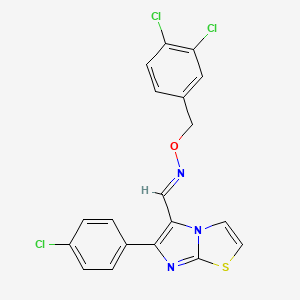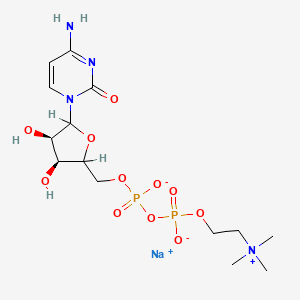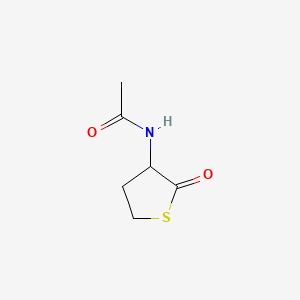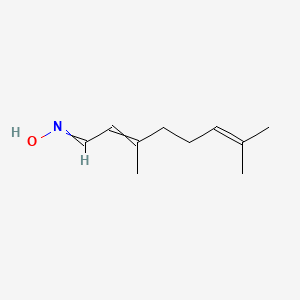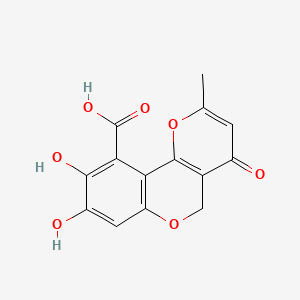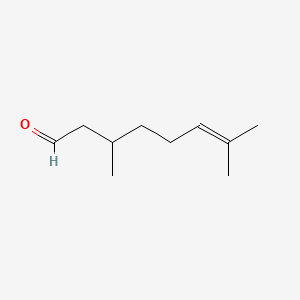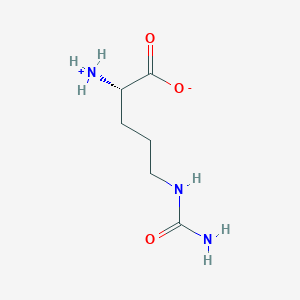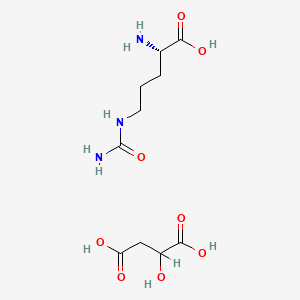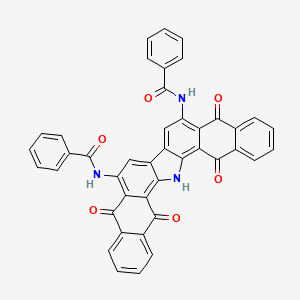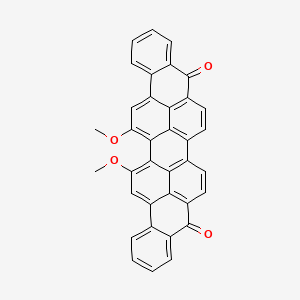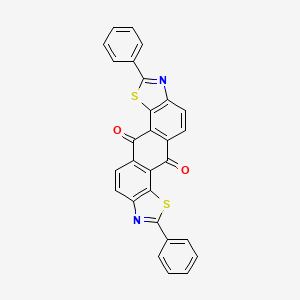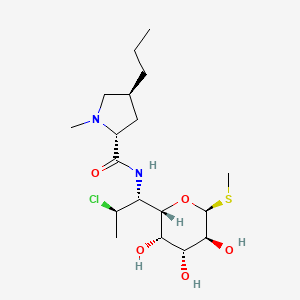
克林霉素
描述
克林霉素是一种林可霉素类抗生素,用于治疗多种细菌感染。它对厌氧菌和某些革兰氏阳性菌,包括葡萄球菌和链球菌,特别有效。 克林霉素通常用于治疗骨髓炎、盆腔炎、链球菌性咽炎、肺炎和皮肤感染等感染 . 它有多种剂型,包括口服胶囊、外用乳膏和静脉注射液 .
作用机制
克林霉素通过与细菌的50S核糖体亚基结合,抑制蛋白质合成来发挥作用。 这种作用阻止了翻译过程中肽链的延伸,有效地阻止了细菌生长 . 克林霉素靶向细菌核糖体,破坏转肽反应,抑制早期链延伸 .
科学研究应用
克林霉素具有广泛的科学研究应用:
化学: 它被用作研究抗生素合成和修饰的模型化合物。
生物学: 克林霉素被用于研究细菌蛋白质合成和抗药性机制。
医学: 它被广泛用于治疗细菌感染,包括由耐甲氧西林金黄色葡萄球菌 (MRSA) 和厌氧菌引起的感染
工业: 克林霉素用于制药行业生产各种抗生素制剂.
生化分析
Biochemical Properties
Clindamycin works primarily by binding to the 50S ribosomal subunit of bacteria . This agent disrupts protein synthesis by interfering with the transpeptidation reaction, which thereby inhibits early chain elongation . By disrupting bacterial protein synthesis, clindamycin causes changes in the cell wall surface, which decreases adherence of bacteria to host cells and increases intracellular killing of organisms .
Cellular Effects
Clindamycin achieves high intracellular levels in phagocytic cells . By disrupting bacterial protein synthesis, clindamycin causes changes in the cell wall surface, which decreases adherence of bacteria to host cells and increases intracellular killing of organisms .
Molecular Mechanism
Clindamycin inhibits bacterial protein synthesis by binding to 23S RNA of the 50S subunit of the bacterial ribosome . It impedes both the assembly of the ribosome and the translation process . The molecular mechanism through which this occurs is thought to be due to clindamycin’s three-dimensional structure, which closely resembles the 3’-ends of L-Pro-Met-tRNA and deacylated-tRNA during the peptide elongation cycle .
Temporal Effects in Laboratory Settings
Clindamycin exerts an extended postantibiotic effect against some strains of bacteria, which may be attributed to persistence of the drug at the ribosomal binding site .
Dosage Effects in Animal Models
In veterinary medicine, clindamycin is used at a dosage of 10-15 mg/kg, administered orally or intravenously every 12-24 hours . There are rarely reported cases of overdosage since clindamycin is well tolerated even at high dosages .
Metabolic Pathways
Clindamycin undergoes hepatic metabolism mediated primarily by CYP3A4 and, to a lesser extent, CYP3A5 . Two inactive metabolites have been identified - an oxidative metabolite, clindamycin sulfoxide, and an N-demethylated metabolite, N-desmethylclindamycin .
Transport and Distribution
Clindamycin is widely distributed in the body, including into bone, but does not distribute into cerebrospinal fluid . The volume of distribution has been variably estimated between 43-74 L .
Subcellular Localization
The primary targets of clindamycin, the 50S ribosomal subunits, are located in the cytoplasm of the bacterial cell . Therefore, the subcellular localization of clindamycin would be within the bacterial cytoplasm where it can exert its effects .
准备方法
克林霉素是由林可霉素合成而来,林可霉素是一种天然抗生素。 合成过程包括对林可霉素进行氯化,用氯原子取代7位羟基 . 过程包括以下几个步骤:
硅保护基团应用: 林可霉素首先使用硅基团进行保护。
选择性脱保护: 受保护的林可霉素进行选择性脱保护。
米氏反应: 脱保护的林可霉素进行米氏反应。
水解反应: 然后将产物水解得到7-差向异构体林可霉素。
氯化反应: 最后,将7-差向异构体林可霉素进行氯化,得到克林霉素.
化学反应分析
克林霉素会发生各种化学反应,包括:
氧化: 克林霉素可以被氧化形成亚砜和N-脱甲基代谢物。
还原: 还原反应不太常见,但可能在特定条件下发生。
取代: 米氏取代反应是其合成过程中的关键步骤.
这些反应中常用的试剂包括氯化剂、氧化剂和还原剂。 这些反应的主要产物是克林霉素盐酸盐及其代谢物 .
相似化合物的比较
克林霉素通常与其他抗生素进行比较,例如:
林可霉素: 克林霉素是林可霉素的氯化衍生物,具有改进的特性。
阿莫西林: 一种青霉素类抗生素,用于治疗类似的感染,但作用机制不同。
多西环素: 一种四环素类抗生素,具有更广谱的活性
属性
IUPAC Name |
(2S,4R)-N-[(1S,2S)-2-chloro-1-[(2R,3R,4S,5R,6R)-3,4,5-trihydroxy-6-methylsulfanyloxan-2-yl]propyl]-1-methyl-4-propylpyrrolidine-2-carboxamide | |
|---|---|---|
| Source | PubChem | |
| URL | https://pubchem.ncbi.nlm.nih.gov | |
| Description | Data deposited in or computed by PubChem | |
InChI |
InChI=1S/C18H33ClN2O5S/c1-5-6-10-7-11(21(3)8-10)17(25)20-12(9(2)19)16-14(23)13(22)15(24)18(26-16)27-4/h9-16,18,22-24H,5-8H2,1-4H3,(H,20,25)/t9-,10+,11-,12+,13-,14+,15+,16+,18+/m0/s1 | |
| Source | PubChem | |
| URL | https://pubchem.ncbi.nlm.nih.gov | |
| Description | Data deposited in or computed by PubChem | |
InChI Key |
KDLRVYVGXIQJDK-AWPVFWJPSA-N | |
| Source | PubChem | |
| URL | https://pubchem.ncbi.nlm.nih.gov | |
| Description | Data deposited in or computed by PubChem | |
Canonical SMILES |
CCCC1CC(N(C1)C)C(=O)NC(C2C(C(C(C(O2)SC)O)O)O)C(C)Cl | |
| Source | PubChem | |
| URL | https://pubchem.ncbi.nlm.nih.gov | |
| Description | Data deposited in or computed by PubChem | |
Isomeric SMILES |
CCC[C@@H]1C[C@H](N(C1)C)C(=O)N[C@@H]([C@@H]2[C@@H]([C@@H]([C@H]([C@H](O2)SC)O)O)O)[C@H](C)Cl | |
| Source | PubChem | |
| URL | https://pubchem.ncbi.nlm.nih.gov | |
| Description | Data deposited in or computed by PubChem | |
Molecular Formula |
C18H33ClN2O5S | |
| Source | PubChem | |
| URL | https://pubchem.ncbi.nlm.nih.gov | |
| Description | Data deposited in or computed by PubChem | |
Related CAS |
21462-39-5 (mono-hydrochloride), 58207-19-5 (mono-HCl, mono-hydrate) | |
| Record name | Clindamycin [USAN:INN:BAN] | |
| Source | ChemIDplus | |
| URL | https://pubchem.ncbi.nlm.nih.gov/substance/?source=chemidplus&sourceid=0018323449 | |
| Description | ChemIDplus is a free, web search system that provides access to the structure and nomenclature authority files used for the identification of chemical substances cited in National Library of Medicine (NLM) databases, including the TOXNET system. | |
DSSTOX Substance ID |
DTXSID2022836 | |
| Record name | Clindamycin | |
| Source | EPA DSSTox | |
| URL | https://comptox.epa.gov/dashboard/DTXSID2022836 | |
| Description | DSSTox provides a high quality public chemistry resource for supporting improved predictive toxicology. | |
Molecular Weight |
425.0 g/mol | |
| Source | PubChem | |
| URL | https://pubchem.ncbi.nlm.nih.gov | |
| Description | Data deposited in or computed by PubChem | |
Mechanism of Action |
Clindamycin may be bacteriostatic or bactericidal in action, depending on the concentration of the drug attained at the site of infection and the susceptibility of the infecting organism. Clindamycin palmitate hydrochloride and clindamycin phosphate are inactive until hydrolyzed to free clindamycin. This hydrolysis occurs rapidly in vivo. Clindamycin appears to inhibit protein synthesis in susceptible organisms by binding to 50S ribosomal subunits; the primary effect is inhibition of peptide bond formation. The site of action appears to be the same as that of erythromycin, chloramphenicol, and lincomycin., Clindamycin binds exclusively to the 50S subunit of bacterial ribosomes and suppresses protein synthesis., ... Clindamycin is not a substrate for macrolide efflux pumps, and strains that are resistant to macrolides by this mechanism are susceptible to clindamycin. | |
| Record name | CLINDAMYCIN | |
| Source | Hazardous Substances Data Bank (HSDB) | |
| URL | https://pubchem.ncbi.nlm.nih.gov/source/hsdb/3037 | |
| Description | The Hazardous Substances Data Bank (HSDB) is a toxicology database that focuses on the toxicology of potentially hazardous chemicals. It provides information on human exposure, industrial hygiene, emergency handling procedures, environmental fate, regulatory requirements, nanomaterials, and related areas. The information in HSDB has been assessed by a Scientific Review Panel. | |
Color/Form |
Yellow, amorphous solid | |
CAS No. |
18323-44-9 | |
| Record name | Clindamycin | |
| Source | CAS Common Chemistry | |
| URL | https://commonchemistry.cas.org/detail?cas_rn=18323-44-9 | |
| Description | CAS Common Chemistry is an open community resource for accessing chemical information. Nearly 500,000 chemical substances from CAS REGISTRY cover areas of community interest, including common and frequently regulated chemicals, and those relevant to high school and undergraduate chemistry classes. This chemical information, curated by our expert scientists, is provided in alignment with our mission as a division of the American Chemical Society. | |
| Explanation | The data from CAS Common Chemistry is provided under a CC-BY-NC 4.0 license, unless otherwise stated. | |
| Record name | Clindamycin [USAN:INN:BAN] | |
| Source | ChemIDplus | |
| URL | https://pubchem.ncbi.nlm.nih.gov/substance/?source=chemidplus&sourceid=0018323449 | |
| Description | ChemIDplus is a free, web search system that provides access to the structure and nomenclature authority files used for the identification of chemical substances cited in National Library of Medicine (NLM) databases, including the TOXNET system. | |
| Record name | Clindamycin | |
| Source | EPA DSSTox | |
| URL | https://comptox.epa.gov/dashboard/DTXSID2022836 | |
| Description | DSSTox provides a high quality public chemistry resource for supporting improved predictive toxicology. | |
| Record name | Clindamycin | |
| Source | European Chemicals Agency (ECHA) | |
| URL | https://echa.europa.eu/substance-information/-/substanceinfo/100.038.357 | |
| Description | The European Chemicals Agency (ECHA) is an agency of the European Union which is the driving force among regulatory authorities in implementing the EU's groundbreaking chemicals legislation for the benefit of human health and the environment as well as for innovation and competitiveness. | |
| Explanation | Use of the information, documents and data from the ECHA website is subject to the terms and conditions of this Legal Notice, and subject to other binding limitations provided for under applicable law, the information, documents and data made available on the ECHA website may be reproduced, distributed and/or used, totally or in part, for non-commercial purposes provided that ECHA is acknowledged as the source: "Source: European Chemicals Agency, http://echa.europa.eu/". Such acknowledgement must be included in each copy of the material. ECHA permits and encourages organisations and individuals to create links to the ECHA website under the following cumulative conditions: Links can only be made to webpages that provide a link to the Legal Notice page. | |
| Record name | CLINDAMYCIN | |
| Source | FDA Global Substance Registration System (GSRS) | |
| URL | https://gsrs.ncats.nih.gov/ginas/app/beta/substances/3U02EL437C | |
| Description | The FDA Global Substance Registration System (GSRS) enables the efficient and accurate exchange of information on what substances are in regulated products. Instead of relying on names, which vary across regulatory domains, countries, and regions, the GSRS knowledge base makes it possible for substances to be defined by standardized, scientific descriptions. | |
| Explanation | Unless otherwise noted, the contents of the FDA website (www.fda.gov), both text and graphics, are not copyrighted. They are in the public domain and may be republished, reprinted and otherwise used freely by anyone without the need to obtain permission from FDA. Credit to the U.S. Food and Drug Administration as the source is appreciated but not required. | |
| Record name | CLINDAMYCIN | |
| Source | Hazardous Substances Data Bank (HSDB) | |
| URL | https://pubchem.ncbi.nlm.nih.gov/source/hsdb/3037 | |
| Description | The Hazardous Substances Data Bank (HSDB) is a toxicology database that focuses on the toxicology of potentially hazardous chemicals. It provides information on human exposure, industrial hygiene, emergency handling procedures, environmental fate, regulatory requirements, nanomaterials, and related areas. The information in HSDB has been assessed by a Scientific Review Panel. | |
Retrosynthesis Analysis
AI-Powered Synthesis Planning: Our tool employs the Template_relevance Pistachio, Template_relevance Bkms_metabolic, Template_relevance Pistachio_ringbreaker, Template_relevance Reaxys, Template_relevance Reaxys_biocatalysis model, leveraging a vast database of chemical reactions to predict feasible synthetic routes.
One-Step Synthesis Focus: Specifically designed for one-step synthesis, it provides concise and direct routes for your target compounds, streamlining the synthesis process.
Accurate Predictions: Utilizing the extensive PISTACHIO, BKMS_METABOLIC, PISTACHIO_RINGBREAKER, REAXYS, REAXYS_BIOCATALYSIS database, our tool offers high-accuracy predictions, reflecting the latest in chemical research and data.
Strategy Settings
| Precursor scoring | Relevance Heuristic |
|---|---|
| Min. plausibility | 0.01 |
| Model | Template_relevance |
| Template Set | Pistachio/Bkms_metabolic/Pistachio_ringbreaker/Reaxys/Reaxys_biocatalysis |
| Top-N result to add to graph | 6 |
Feasible Synthetic Routes
Q1: How does Clindamycin exert its antibacterial effect?
A1: Clindamycin inhibits bacterial protein synthesis by binding to the 50S ribosomal subunit, specifically at the center of the peptidyl transferase center. [, , ] This binding prevents peptide bond formation and disrupts the translocation process, ultimately halting protein synthesis and leading to bacterial growth inhibition or death. [, ]
Q2: Does Clindamycin possess any anti-inflammatory properties?
A3: Yes, in addition to its antibacterial action, Clindamycin also exhibits anti-inflammatory effects. [] It has been shown to reduce inflammation associated with acne by influencing inflammatory pathways and potentially inhibiting neutrophil chemotaxis. []
Q3: What is the molecular formula and weight of Clindamycin?
A4: The molecular formula of Clindamycin is C18H33ClN2O5S, and its molecular weight is 424.98 g/mol. []
Q4: How stable are intravenous admixtures containing Clindamycin?
A6: Intravenous admixtures of Clindamycin phosphate with aztreonam at specific concentrations have demonstrated stability for at least 48 hours at 22-23°C and for at least seven days at 4°C. []
Q5: How do structural modifications of Clindamycin affect its activity?
A7: Research shows that the presence of the 7(S)-chloro-7-deoxy function in Clindamycin is crucial for its potent antibacterial activity. [] Alterations to this specific structural feature can significantly impact Clindamycin's ability to bind to the bacterial ribosome and inhibit protein synthesis. []
Q6: What are some strategies to enhance Clindamycin's delivery to target tissues?
A8: One approach involves encapsulating Clindamycin phosphate into transfersomal nanoparticles. [] These nanoparticles have been shown to improve the drug's transdermal delivery and penetration into deeper skin layers, potentially enhancing its efficacy for treating skin infections. []
Q7: Can bile acids improve Clindamycin's permeation through the skin?
A9: Yes, incorporating bile acids like cholic acid into Clindamycin hydrogel formulations has been shown to enhance the drug's release rate and permeation through cellulose membranes in vitro. [] This finding suggests the potential for bile acids to improve Clindamycin's penetration through the skin barrier. []
Q8: How is Clindamycin absorbed and distributed in the body?
A10: Clindamycin is rapidly absorbed after oral administration, reaching peak plasma concentrations in about 0.5 hours. [] It demonstrates good tissue penetration and is known to accumulate in phagocytes, which can be beneficial for treating intracellular infections. [, ]
Q9: Are there differences in bioavailability between Clindamycin phosphate ester tablets and Clindamycin hydrochloride capsules?
A11: Studies have shown bioequivalence between orally disintegrating Clindamycin phosphate ester tablets and Clindamycin hydrochloride capsules. [] This suggests that both formulations provide comparable amounts of Clindamycin in the bloodstream. []
Q10: What are some animal models used to study Clindamycin's efficacy?
A12: A murine model has been utilized to investigate Clindamycin's efficacy in treating community-acquired methicillin-resistant Staphylococcus aureus (CA-MRSA) pneumonia. [] Results indicated that Clindamycin effectively reduced bacterial load, improved survival rates, and mitigated lung damage in infected mice. []
Q11: Has Clindamycin been compared to other antibiotics in clinical trials?
A13: Yes, several clinical trials have compared Clindamycin to other antibiotics for treating various infections. For instance, a study on bacterial vaginosis found comparable cure rates between oral metronidazole, metronidazole vaginal gel, and Clindamycin vaginal cream. [] Another trial showed similar efficacy between Clindamycin, amoxicillin, and erythromycin for treating Chlamydia trachomatis in pregnant women. []
Q12: What is the significance of inducible clindamycin resistance in Staphylococcal infections?
A14: Inducible clindamycin resistance (ICR) is a concern in Staphylococcal infections because routine susceptibility tests may misinterpret resistant strains as susceptible. [, , , , , , , ] This misinterpretation can lead to therapeutic failure if Clindamycin is chosen for treatment. [, , , , , , , ] Performing a D-test is crucial to accurately identify ICR and guide appropriate antibiotic selection. [, , , , , , , ]
Q13: What is the most common mechanism behind clindamycin resistance in Staphylococci?
A15: The most prevalent mechanism is through the erm gene, which encodes for ribosomal methylases. [, , , , , , , ] These methylases modify the bacterial ribosome, preventing Clindamycin binding and rendering the bacteria resistant. [, , , , , , , ]
Q14: How does prior clindamycin exposure affect the susceptibility of Clostridium difficile?
A16: Studies indicate that prior clindamycin use is significantly associated with Clostridium difficile-associated diarrhea (CDAD) caused by isolates resistant to clindamycin, erythromycin, and trovafloxacin. [] This association highlights the potential risk of selecting for resistant C. difficile strains following clindamycin exposure. []
Q15: What analytical methods are commonly used to quantify Clindamycin?
A17: High-performance liquid chromatography (HPLC) coupled with UV detection is a widely used method for quantifying Clindamycin in various matrices. [, , ] UPLC-MS (Ultra Performance Liquid Chromatography-Mass Spectrometry) is another powerful technique used to detect and quantify Clindamycin and its related substances, even at low concentrations. []
Q16: How can researchers ensure the accuracy and reliability of their analytical methods for Clindamycin?
A18: Rigorous analytical method validation is essential. This process involves assessing parameters such as accuracy, precision, specificity, linearity, range, limit of detection, limit of quantitation, robustness, and system suitability. [] Validated methods ensure reliable and accurate data for Clindamycin analysis. []
体外研究产品的免责声明和信息
请注意,BenchChem 上展示的所有文章和产品信息仅供信息参考。 BenchChem 上可购买的产品专为体外研究设计,这些研究在生物体外进行。体外研究,源自拉丁语 "in glass",涉及在受控实验室环境中使用细胞或组织进行的实验。重要的是要注意,这些产品没有被归类为药物或药品,他们没有得到 FDA 的批准,用于预防、治疗或治愈任何医疗状况、疾病或疾病。我们必须强调,将这些产品以任何形式引入人类或动物的身体都是法律严格禁止的。遵守这些指南对确保研究和实验的法律和道德标准的符合性至关重要。


